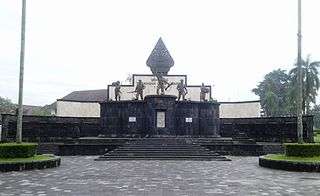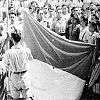General Offensive of 1 March 1949
| General Offensive of 1 March 1949 Serangan Umum 1 Maret 1949 | |||||||
|---|---|---|---|---|---|---|---|
| Part of the Indonesian National Revolution | |||||||
 Monument in Yogyakarta commemorating the offensive. | |||||||
| |||||||
| Belligerents | |||||||
|
|
| ||||||
| Commanders and leaders | |||||||
|
Sultan Hamengkubuwono IX Colonel Bambang Sugeng Colonel Abdul Haris Nasution Lieutenant colonel Suharto |
Major general Langen Major general Meyer Lieutenant colonel J.M. v/d Berge | ||||||
| Units involved | |||||||
| Tentara Republik Indonesia |
Royal Netherlands Army Royal Netherlands East Indies Army | ||||||
| Strength | |||||||
| 10,000–30,000 | 2,000–3,000 | ||||||
| Casualties and losses | |||||||
| 300 soldiers and 53 policemen killed |
3 soldiers killed 3 policemen and 14 soldiers wounded | ||||||

The General Offensive of 1 March 1949 (Indonesian: Serangan Umum 1 Maret 1949) was a military offensive during the Indonesian National Revolution.
Background
Frustrated at negotiations with the Republic and believing it weakened by both the Darul Islam and Madiun insurgencies, the Dutch launched a military offensive on 19 December 1948 which it termed 'Operatie Kraai' (Operation Crow). By the following day it had conquered the city of Yogyakarta, the location of the temporary Republican capital. By the end of December, all major Republican held cities in Java and Sumatra were in Dutch hands. The Republican President, Vice-President, and all but six Republic of Indonesia ministers were captured by Dutch troops and exiled on Bangka Island off the east coast of Sumatra. In areas surrounding Yogyakarta and Surakarta, Republican forces refused to surrender and continued to wage a guerrilla war under the leadership of Republican military chief of staff General Sudirman who had escaped the Dutch offensives. An emergency Republican government, the Pemerintahan Darurat Republik Indonesia (PDRI), was established in West Sumatra.
The offensive
In early 1949, Hamengkubuwono IX conceived the idea of a major offensive to be launched against Yogyakarta and the Dutch troops occupying it.[1] The purpose of this offensive was to show to the world that Indonesia still existed and that it was not ready to surrender. The idea was suggested to General Sudirman, the Commander of the Indonesian Army and received his approval. In February 1949, Hamengkubuwono IX had a meeting with then Lieutenant Colonel Suharto, the man chosen by Sudirman to be the field commander for the offensive. After this discussion, preparations were made for the offensive. This involved intensified guerilla attacks in villages and towns around Yogyakarta so as to make the Dutch station more troops outside of Yogyakarta and thin the numbers in the city itself. On 1 March 1949 at 6 AM, Suharto and his troops launched the 1 March General Offensive. The offensive caught the Dutch by surprise. For his part, Hamengkubuwono IX allowed his palace to be used as a hide out for the troops. For six hours, Indonesian troops maintained control of Yogyakarta before finally retreating. The offensive was a moral and diplomatic success, inspiring troops all around Indonesia, as well as proving to the United Nations that the Indonesian army still existed and were capable of fighting. On the other hand, the offensive had demoralised the Dutch forces, who did not expect Indonesian forces to have the capability to assault and control the city, even for a few hours.
Aftermath
The United Nations already adopted United Nations Security Council Resolution 63 on 24 December 1948,[2] in response to a report by the Committee of Good Offices the Council called upon the parties to cease hostilities and to release the President of the Republic of Indonesia and other political prisoners arrested since 18 December 1948. On 29 June 1949 Yogyakarta was cleared from Dutch forces under the pressure from the United Nations.
The offensive in Indonesian history
In Indonesia the offensive is described as a major success in which the world was shown that the TNI was not easily defeated because of strong local support and positive sentiment. In reality, it shown the falsehood of Dutch propaganda regarding their military superiority. The Dutch military superiority over the Indonesian Army occurred only in urban areas but proven to be incompetent, incapable and reluctant to fight in guerrilla warfare. The Dutch military superiority in armaments and technology reduced by the lack of European personnels and thin supply line which make them heavily rely on Indigenous KNIL soldiers who start to doubt their colonial cause and begin defection to the Republican side before and after the offensive. The Indonesian offensive, later known in Indonesia as Serangan Oemoem (new spelling: Serangan Umum, 'General Offensive'), is commemorated by a large monument in Yogyakarta. It is commemorated every year on March 1 as "Six hours in Jogja".
References
- ↑ "Universitas Gadjah Mada:Historian: Idea on March 1 General Offensive was from Kraton". ugm.ac.id. Retrieved 8 March 2015.
- ↑ ODS Team. "ODS HOME PAGE" (PDF). un.org. Retrieved 8 March 2015.
